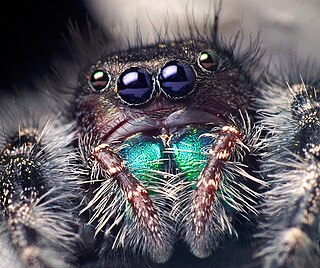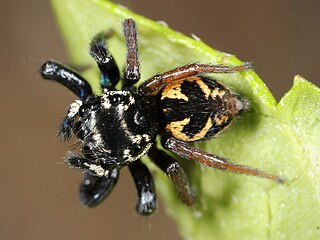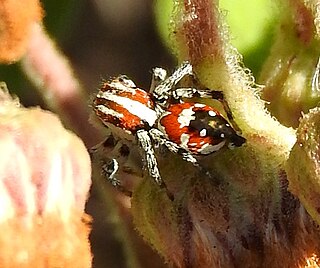
Phidippus is a genus in the family Salticidae. Some of the largest jumping spiders inhabit this genus, and many species are characterized by their brilliant, iridescent green chelicerae. Phidippus is distributed almost exclusively in North America, with the exception of two exported species. As of January 2021, there were about 80 described species in the genus. Species previously described in Phidippus which are found in India and Bangladesh do not belong in this genus.

Beata is a genus of jumping spiders that was first described by George Peckham & Elizabeth Peckham in 1895.

Breda is a genus of jumping spiders that was first described by George Peckham & Elizabeth Peckham in 1894.

Corythalia is a genus of jumping spiders that was first described by Carl Ludwig Koch in 1850. The genus is distributed throughout most of the Western Hemisphere.

Freya is a genus of jumping spiders that was first described by Carl Ludwig Koch in 1850. The name is derived from Freya, the fertility goddess of Norse mythology.

Lyssomanes is a spider genus of the family Salticidae, ranging from South and Central America, up to the southern United States.

Messua is a spider genus of the family Salticidae.

Metacyrba is a genus of jumping spiders that was first described by Frederick Octavius Pickard-Cambridge in 1901. The name is combined from Ancient Greek μετά "after, beside" and the salticid genus Cyrba.

Metaphidippus is a genus of jumping spiders that was first described by Frederick Octavius Pickard-Cambridge in 1901. The name is combined from Ancient Greek μετά "after, beside" and the salticid genus Phidippus.

Nycerella is a genus of spiders of the jumping spider family, Salticidae.

Pachomius is a genus of jumping spiders that was first described by George and Elizabeth Peckham in 1896. Uspachia was merged into genus Romitia in 2007, and all nine species were merged into Pachomius in 2015. The name is derived from Pachomius, the founder of cenobitic monasticism.

Paraphidippus is a genus of jumping spiders that was first described by Frederick Octavius Pickard-Cambridge in 1901. The name is a combination of the Ancient Greek "para" (παρά), meaning "alongside", and the salticid genus Phidippus.

Peckhamia is a genus of jumping spiders that was first described by Eugène Louis Simon in 1900. It is named in honor of George and Elizabeth Peckham, and is considered a senior synonym of the genus Consingis.

Sarinda is a genus of ant mimicking jumping spiders that was first described by George and Elizabeth Peckham in 1892.
Sidusa is a genus of jumping spiders that was first described by George and Elizabeth Peckham in 1895.

Zygoballus is a genus of jumping spiders found in North and South America.

The Dendryphantina are a subtribe of jumping spiders that occur mainly in the New World. The subtribe was first defined by Anton Menge in 1879 as Dendryphantidae. Females of the subtribe generally show paired spots on the abdomen, and the males often have enlarged chelicerae. Females in this subtribe typically have S-shaped epigynal openings.

Zygoballus rufipes, commonly called the hammerjawed jumper, is a species of jumping spider which occurs in the United States, Canada, and Central America. Adult females are 4.3 to 6 mm in body length, while males are 3 to 4 mm.

Colonus is a genus of spiders in the jumping spider family, Salticidae. Colonus species are endemic to North and South America, ranging from New York to Argentina. All members of the genus have two pairs of bulbous spines on the ventral side of the first tibiae. The function of these spines is unknown. Colonus was declared a junior synonym of Thiodina by Eugène Simon in 1903, but this was reversed by Bustamante, Maddison, and Ruiz in 2015.
This page is based on this
Wikipedia article Text is available under the
CC BY-SA 4.0 license; additional terms may apply.
Images, videos and audio are available under their respective licenses.



















